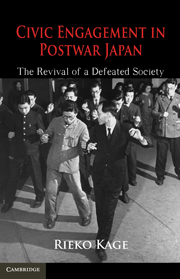Book contents
- Frontmatter
- Contents
- List of Tables
- List of Figures
- Preface
- Acknowledgments
- Civic Engagement in Postwar Japan
- 1 Introduction
- 2 Civic Engagement: The Dependent Variable
- 3 War and Civic Engagement: A Theoretical Framework
- 4 Quantitative Analysis: The Rise of Civic Engagement across Forty-Six Japanese Prefectures
- 5 The Long-Term Effects of Wartime Mobilization: Cross-National Analysis
- 6 Repression and Revival of the YMCA Japan
- 7 Wartime Endorsement and Postwar Repression of a Traditional Art
- 8 Civil Society and Reconstruction in Postwar Japan
- 9 Conclusions
- References
- Index
Preface
Published online by Cambridge University Press: 06 December 2010
- Frontmatter
- Contents
- List of Tables
- List of Figures
- Preface
- Acknowledgments
- Civic Engagement in Postwar Japan
- 1 Introduction
- 2 Civic Engagement: The Dependent Variable
- 3 War and Civic Engagement: A Theoretical Framework
- 4 Quantitative Analysis: The Rise of Civic Engagement across Forty-Six Japanese Prefectures
- 5 The Long-Term Effects of Wartime Mobilization: Cross-National Analysis
- 6 Repression and Revival of the YMCA Japan
- 7 Wartime Endorsement and Postwar Repression of a Traditional Art
- 8 Civil Society and Reconstruction in Postwar Japan
- 9 Conclusions
- References
- Index
Summary
Hiroshima, 1949. Four years earlier, the atomic bomb had completely destroyed the city. There were still many visible signs of damage. In the midst of this devastation, Hiroshima's first professional baseball team came into being.
Professional baseball had been founded in Japan in 1934, but Hiroshima had never had a professional team. Yet baseball at the high school level had been enormously popular in Hiroshima before the war, and the local Hiroshima Commercial High School had won three titles at the national high school baseball tournament (Koshien) during the prewar period. As early as November 1945, a team of local baseball players began playing with the U.S. Occupation forces. Thus, in April 1949, when Matsutaro Shoriki, owner of the Yomiuri Giants, announced a plan to re-organize Japanese professional baseball into two leagues and to vastly expand the number of teams, local business leaders in Hiroshima sprang into action and sent in an application. They saw baseball as a way to revitalize the war-torn city. The new Hiroshima Carp, as the team would be called, was accepted into the Central League, and in 1950 the team played its first full season. Crowds flocked to the stadium to watch the games.
The problem was funding. Most of the professional teams that were in existence at the time were owned by big corporations that were willing to run a deficit on the team in order to generate publicity for their main line of business.
- Type
- Chapter
- Information
- Civic Engagement in Postwar JapanThe Revival of a Defeated Society, pp. xi - xiiPublisher: Cambridge University PressPrint publication year: 2010

